Fatigue Life Predictions Using a Novel Adaptive Meshing Technique in Non-Linear Finite Element Analysis
Abstract
1. Introduction
- (a)
- Developing a reliable and robust 3D non-linear FE model using SMART re-meshing technology capable of predicting the dynamic stress intensity factor and fatigue life of pre-cracked steel beams.
- (b)
- Understanding the effect of different design parameters such as the crack growth length and FRP braid angle and type on fatigue life assessment of pre-cracked steel beams through an extensive parametric investigation.
2. Methods
2.1. The Fatigue Crack Growth Procedure
- KI, KII, and KIII are the Mode I, II, and III SIFs, respectively;
- , , and are the auxiliary Mode I, II, and III SIFs, respectively;
- E* = E for the plane stress and for the plane strain;
- E, G, and ν are the Young’s modulus, shear modulus, and Poisson’s ratio of the material, respectively.
- da/dN = the rate of crack growth in mm/cycles;
- ΔK = the range of the SIF in MPa.mm1/2;
- “C” and “m” = Paris’ law constants depending on the material characteristics as well as the stress ratio.
2.2. Validation of the FE Model
3. Design of Pre-Cracked Steel Beams with and without FRP Strengthening
3.1. A Pre-Cracked Steel I-Beam (B01) without FRP Strengthening
3.2. The Parametric Study
- The Paris’ law parameters are the same for the unstrengthened and FRP-strengthened steel beams, implying that the FRP laminate only contributes to reducing the SIF at the crack tip [52].
- There is no debonding between the FRP laminate and the steel beam interface (i.e., perfect bonding), which is achieved by merging the nodes of the beam’s bottom flange and the FRP laminate’s top face [60].
4. Conclusions
- ❖
- The various challenges associated with the simulation of FRP composites, like their orthotropic response, fiber braid angle, ply thickness, and stacking sequence, are handled using ANSYS ACP, an appropriate tool for modeling advanced composite materials.
- ❖
- From the results of the parametric study, it is evident that the FRP’s tensile stress is greatest for the beams strengthened with FRP and with longitudinally oriented fibers (θ = 0°), and it is minimal for those reinforced with FRP and with transversely oriented fibers, which helps to the delay the crack growth, reduce the SIF, and increase the fatigue life for all the reinforced beams up to the last step of crack growth.
- ❖
- A SIF reduction factor K’ based on a semi-empirical approach and a fatigue life enhancement factor N’ are calculated for all of the FRP-strengthened beams for comparison with the unstrengthened beams.
- ❖
- CFRP exhibits a notably superior performance compared to GFRP, especially regarding the extension of the fatigue life, in the case of longitudinally oriented fibers (θ = 0°). However, an increase in the fiber braid angle (>30°) did not show any significant improvement in the fatigue life of the pre-cracked steel beams.
- ❖
- From the results available in the present work, the following generic design suggestions can be made:
- (a)
- The use of FRP with longitudinally oriented fibers (θ = 0°) can provide good enhancements to the stress intensity factor and the fatigue life prediction factors of notched steel sections.
- (b)
- For achievement of the desired fatigue performance, the selection of the type of fiber used in composites holds as a key factor. For heavily distressed structures, the use of carbon FRP can be recommended. However, for lightly or moderately distressed structures, the use of glass FRP is recommended for practical considerations.
- (c)
- Though the use of FRP composites in enhancing the fatigue life of notched steel beams has been studied, their long-term effectiveness in terms of durability is important and yet to be understood, which will be within scope for further studies.
Author Contributions
Funding
Data Availability Statement
Conflicts of Interest
References
- Abeygunasekara, S.; Gamage, J.C.P.; Fawzia, S. Investigation of Crack Repairing Technique to Delay Fracture Initiation of Steel Members Subjected to Low Cycle Fatigue. Buildings 2023, 13, 2958. [Google Scholar] [CrossRef]
- Diao, Y.; He, S.; Wang, Y.; Tu, L. Experimental and Numerical Investigations on Stress Concentration Factors of Concrete Filled Steel Tube X-Joints. Sci. Rep. 2024, 14, 11415. [Google Scholar] [CrossRef]
- Wang, Q.J.; Chung, Y.W. (Eds.) Fatigue of Materials. In Encyclopedia of Tribology; Springer: Boston, MA, USA, 2013. [Google Scholar] [CrossRef]
- Paul Paris, M.G.W.A. A Rational Analytic Theory of Fatigue_Paris_Base Ref. Trend Eng. 1961, 9–14. [Google Scholar]
- Wöhler, A. Versuche zur Ermittlung der Auf die Eisenbahnwagenachsen Einwirkenden Kräfte und die Widerstandsfähigkeit der Wagen-Achsen. Z. Für Bauwes. 1860, 10, 583–614. [Google Scholar]
- Coffin, L. Fatigue and Endurance of Metals. In Cyclic Deformation and Fatigue of Metals (Russian Translation); USSR: Moscow, Russia, 1963; pp. 257–272. [Google Scholar]
- Cui, W. A state-of-the-art review on fatigue life prediction methods for metal structures. J. Mar. Sci. Technol. 2002, 7, 43–56. [Google Scholar] [CrossRef]
- Makkonen, M. Predicting the Total Fatigue Life in Metals. Int. J. Fatigue 2009, 31, 1163–1175. [Google Scholar] [CrossRef]
- Paris, P.; Director, A.; Erdogan, F. A Critical Analysis of Crack Propagation Laws. J. Basic Eng. 1963, 85, 528–533. [Google Scholar] [CrossRef]
- Li, H.F.; Zhang, P.; Wang, B.; Zhang, Z.F. Predictive Fatigue Crack Growth Law of High-Strength Steels. J. Mater. Sci. Technol. 2022, 100, 46–50. [Google Scholar] [CrossRef]
- Zhang, K.; Zhang, J.; Jin, W.; Mao, J.; Li, Q.; Xu, F. A Novel Method for Characterizing the Fatigue Crack Propagation of Steel via the Weak Magnetic Effect. Int. J. Fatigue 2021, 146, 106166. [Google Scholar] [CrossRef]
- Li, H.F.; Liu, Y.Q.; Zhang, P.; Zhang, Z.F. A Full-Stage Fatigue Crack Growth Model for Metallic Materials. Int. J. Fatigue 2023, 172, 107662. [Google Scholar] [CrossRef]
- Li, X.K.; Zhu, S.P.; Liao, D.; Correia, J.A.F.O.; Berto, F.; Wang, Q. Probabilistic Fatigue Modelling of Metallic Materials under Notch and Size Effect Using the Weakest Link Theory. Int. J. Fatigue 2022, 159, 106788. [Google Scholar] [CrossRef]
- Faghihi, D.; Sarkar, S.; Naderi, M.; Rankin, J.E.; Hackel, L.; Iyyer, N. A Probabilistic Design Method for Fatigue Life of Metallic Component. ASCE-ASME J. Risk Uncertain. Eng. Syst. Part B Mech. Eng. 2017, 4, 031005. [Google Scholar] [CrossRef]
- Liao, D.; Zhu, S.P.; Keshtegar, B.; Qian, G.; Wang, Q. Probabilistic Framework for Fatigue Life Assessment of Notched Components under Size Effects. Int. J. Mech. Sci. 2020, 181, 105685. [Google Scholar] [CrossRef]
- Maljaars, J.; Leonetti, D.; Hashemi, B.; Snijder, H. Systematic Derivation of Safety Factors for the Fatigue Design of Steel Bridges. Struct. Saf. 2022, 97, 102229. [Google Scholar] [CrossRef]
- Hu, W.; Zhou, B.; Zheng, X. Fatigue Evaluation of CFST Arch Bridge Based on Vehicle–Bridge Coupling Vibration Analysis. Buildings 2024, 14, 1787. [Google Scholar] [CrossRef]
- Fett, T. Stress Intensity Factors-T-Stresses-Weight Functions. Supplement Volume; KIT Scientific Publishing: Karlsruhe, Germany, 2014; Volume 55. [Google Scholar]
- Tada, H.; Paris, P.C.; Irwin, G.R. The Stress Analysis of Cracks Handbook; American Society of Mechanical Engineers: New York, NY, USA, 1973; Volume 34. [Google Scholar]
- Moiler, W.H.; Herrmann, G.; Gao, H. Elementary Strength Theory of Cracked Beams. Theor. Appl. Fract. Mech. 1993, 18, 163–177. [Google Scholar] [CrossRef]
- Dunn, M.L.; Suwito, W.; Hunter, B. Stress Intensity Factors for Cracked I-Beams. Eng. Fract. Mech. 1997, 57, 609–615. [Google Scholar] [CrossRef]
- Selvaraj, S.; Madhavan, M. Strengthening of Laterally Restrained Steel Beams Subjected to Flexural Loading Using Low-Modulus CFRP. J. Perform. Constr. Facil. 2019, 33, 1–15. [Google Scholar] [CrossRef]
- Brindha, U.; Maheswaran, J.; Chellapandian, M.; Arunachelam, N. Quantitative Assessment of Strengthening Strategies and Design Recommendations for the Repair of Corrosion-Damaged Reinforced Concrete Members. Buildings 2023, 13, 1080. [Google Scholar] [CrossRef]
- Selvaraj, S.; Madhavan, M. Strengthening of Unsymmetrical Open Channel Built-up Beams Using CFRP. Thin-Walled Struct. 2017, 119, 615–628. [Google Scholar] [CrossRef]
- Selvaraj, S.; Madhavan, M. Design of Steel Beams Strengthened with Low-Modulus CFRP Laminates. J. Compos. Constr. 2020, 24, 04019052. [Google Scholar] [CrossRef]
- Maheswaran, J.; Chellapandian, M.; Arunachelam, N. Retrofitting of severely damaged RC members using fiber reinforced polymer composites: A comprehensive review. Structures 2022, 38, 1257–1276. [Google Scholar] [CrossRef]
- Silwal, P.K.; Parvin, A.; Alhusban, M. Numerical Investigation on Strengthening of Steel Beams for Corrosion Damage or Web Openings Using Carbon Fiber Reinforced Polymer Sheets. Buildings 2024, 14, 1069. [Google Scholar] [CrossRef]
- AbouEl-Hamd, O.R.; Sweedan, A.M.I.; El-Ariss, B. Flexural Performance of Steel Beams Strengthened by Fastened Hybrid FRP Strips Utilizing Staggered Steel Bolts. Buildings 2022, 12, 2150. [Google Scholar] [CrossRef]
- Keykha, A.H. Structural Performance Evaluation of Deficient Steel Members Strengthened Using CFRP under Combined Tensile, Torsional and Lateral Loading. J. Build. Eng. 2019, 24, 100746. [Google Scholar] [CrossRef]
- Yoresta, F.S.; Nhut, P.V.; Nakamoto, D.; Matsumoto, Y. Enhancing Buckling Capacity of Angle Steel Using Unbonded CFRP Laminates Processed by Vacuum-Assisted Resin Transfer Molding (VaRTM). Structures 2022, 41, 173–189. [Google Scholar] [CrossRef]
- Chellapandian, M.; Jain, S.; Prakash, S.S.; Sharma, A. Effect of cyclic damage on the performance of RC square columns strengthened using hybrid FRP composites under Axial Compression. Fibers 2019, 7, 90. [Google Scholar] [CrossRef]
- Ghafoori, E.; Motavalli, M. Lateral-Torsional Buckling of Steel I-Beams Retrofitted by Bonded and Un-Bonded CFRP Laminates with Different Pre-Stress Levels: Experimental and Numerical Study. Constr. Build. Mater. 2015, 76, 194–206. [Google Scholar] [CrossRef]
- Yu, Y.; Chiew, S.P.; Lee, C.K. Bond Failure of Steel Beams Strengthened with FRP Laminates—Part 2: Verification. Compos. Part B Eng. 2011, 42, 1122–1134. [Google Scholar] [CrossRef]
- Photiou, N.K.; Hollaway, L.C.; Chryssanthopoulos, M.K. Strengthening of an Artificially Degraded Steel Beam Utilising a Carbon/Glass Composite System. Constr. Build. Mater. 2006, 20, 11–21. [Google Scholar] [CrossRef]
- Patil, V.M.; Awati, M.M.; Ahankari, S.S.; Lande, A.C. Enhancing Rolled Steel I Beam Performance Through FRP Strengthening: Analytical and Numerical Modelling for Behavior Prediction. J. Inst. Eng. Ser. A 2024, 105, 563–580. [Google Scholar] [CrossRef]
- Fernando, D.; Schumacher, A.; Motavalli, M.; Teng, J.G.; Yu, T.; Ghafoori, E. Fatigue Strengthening of Cracked Steel Beams with CFRP Plates. ASME Int. Mech. Eng. Congr. Expo. Proc. 2010, 9, 271–276. [Google Scholar] [CrossRef]
- Wu, G.; Wang, H.-T.; Wu, Z.-S.; Liu, H.-Y.; Ren, Y. Experimental Study on the Fatigue Behavior of Steel Beams Strengthened with Different Fiber-Reinforced Composite Plates. J. Compos. Constr. 2012, 16, 127–137. [Google Scholar] [CrossRef]
- Kamruzzaman, M.; Jumaat, M.Z.; Ramli Sulong, N.H.; Islam, A.B.M.S. A Review on Strengthening Steel Beams Using FRP under Fatigue. Sci. World J. 2014, 2014, 702537. [Google Scholar] [CrossRef]
- Hu, L.; Feng, P.; Zhao, X.L. Fatigue Design of CFRP Strengthened Steel Members. Thin-Walled Struct. 2017, 119, 482–498. [Google Scholar] [CrossRef]
- Bagale, B.R.; Parvin, A. Fiber-Reinforced Polymer Strengthening of Steel Beams under Static and Fatigue Loadings. Pract. Period. Struct. Des. Constr. 2021, 26, 04020046. [Google Scholar] [CrossRef]
- Colombi, P.; Fava, G. Fatigue Crack Growth in Steel Beams Strengthened by CFRP Strips. Theor. Appl. Fract. Mech. 2016, 85, 173–182. [Google Scholar] [CrossRef]
- Colombi, P.; Fava, G. Experimental Study on the Fatigue Behaviour of Cracked Steel Beams Repaired with CFRP Plates. Eng. Fract. Mech. 2015, 145, 128–142. [Google Scholar] [CrossRef]
- Yu, Q.Q.; Wu, Y.F. Fatigue Durability of Cracked Steel Beams Retrofitted with High-Strength Materials. Constr. Build. Mater. 2017, 155, 1188–1197. [Google Scholar] [CrossRef]
- Hosseini, S.M.; Melchior, J.; Izadi, M.; Ghafoori, E. Fatigue Crack Arrest in Steel Beams Using FRP Composites. Eng. Fail. Anal. 2021, 127, 105397. [Google Scholar] [CrossRef]
- Yu, Q.-Q.; Wu, Y.-F. Fatigue Strengthening of Cracked Steel Beams with Different Configurations and Materials. J. Compos. Constr. 2017, 21, 04016093. [Google Scholar] [CrossRef]
- Hmidan, A.; Kim, Y.J.; Yazdani, S. Stress Intensity Factors for Cracked Steel Girders Strengthened with CFRP Sheets. J. Compos. Constr. 2015, 19, 04014085. [Google Scholar] [CrossRef]
- Bashiri, A.H.; Alshoaibi, A.M. Adaptive Finite Element Prediction of Fatigue Life and Crack Path in 2d Structural Components. Metals 2020, 10, 1316. [Google Scholar] [CrossRef]
- Fageehi, Y.A. Fatigue Crack Growth Analysis with Extended Finite Element for 3d Linear Elastic Material. Metals 2021, 11, 397. [Google Scholar] [CrossRef]
- Alshoaibi, A.M.; Ali Fageehi, Y. 3D Modelling of Fatigue Crack Growth and Life Predictions Using ANSYS. Ain Shams Eng. J. 2022, 13, 101636. [Google Scholar] [CrossRef]
- Lv, W.; Ding, B.; Zhang, K.; Qin, T. High-Cycle Fatigue Crack Growth in T-Shaped Tubular Joints. Buildings 2023, 13, 2722. [Google Scholar] [CrossRef]
- Bergara, A.; Dorado, J.I.; Martin-Meizoso, A.; Martínez-Esnaola, J.M. Fatigue Crack Propagation in Complex Stress Fields: Experiments and Numerical Simulations Using the Extended Finite Element Method (XFEM). Int. J. Fatigue 2017, 103, 112–121. [Google Scholar] [CrossRef]
- Lepretre, E.; Chataigner, S.; Dieng, L.; Gaillet, L. Stress Intensity Factor Assessment for the Reinforcement of Cracked Steel Plates Using Prestressed or Non-Prestressed Adhesively Bonded CFRP. Materials 2021, 14, 1625. [Google Scholar] [CrossRef]
- Mohajer, M.; Bocciarelli, M.; Colombi, P.; Hosseini, A.; Nussbaumer, A.; Ghafoori, E. Irreversible Cyclic Cohesive Zone Model for Prediction of Mode I Fatigue Crack Growth in CFRP-Strengthened Steel Plates. Theor. Appl. Fract. Mech. 2020, 110, 102804. [Google Scholar] [CrossRef]
- Reimers, P. Simulation of Mixed Mode Fatigue Crack Growth. Comput. Struct. 1991, 40, 339–346. [Google Scholar] [CrossRef]
- Kim, K.S.; Lee, H.S. An Incremental Formulation for the Prediction of Two-Dimensional Fatigue Crack Growth with Curved Paths. Int. J. Numer. Methods Eng. 2007, 72, 697–721. [Google Scholar] [CrossRef]
- ASTMC 273/C 273M-06; Standard Test Method for Shear Properties of Sandwich Core Materials. ITeh Standards: Newark, DE, USA, 2010.
- Sajith, S.; Krishna Murthy, K.S.R.; Robi, P.S. Prediction of Accurate Mixed Mode Fatigue Crack Growth Curves Using the Paris’ Law. J. Inst. Eng. Ser. C 2019, 100, 165–174. [Google Scholar] [CrossRef]
- Alshoaibi, A.M.; Fageehi, Y.A. Numerical Analysis of Fatigue Crack Growth Path and Life Predictions for Linear Elastic Material. Materials 2020, 13, 3380. [Google Scholar] [CrossRef] [PubMed]
- Mlikota, M.; Staib, S.; Schmauder, S.; Božić, Ž. Numerical Determination of Paris Law Constants for Carbon Steel Using a Two-Scale Model. J. Phys. Conf. Ser. 2017, 843, 012042. [Google Scholar] [CrossRef]
- ANSYS. Fracture Analysis Guide; ANSYS, Inc.: Canonsburg, PA, USA, 2022. [Google Scholar]
- Gürdal, Z.; Haftka, R.T.; Hajela, P. Design and Optimization of Laminated Composite Materials; John Wiley & Sons: Hoboken, NJ, USA, 1999. [Google Scholar]
- Jones, R.M. Mechanics of Composite Materials; CRC Press: Boca Raton, FL, USA, 2018. [Google Scholar]


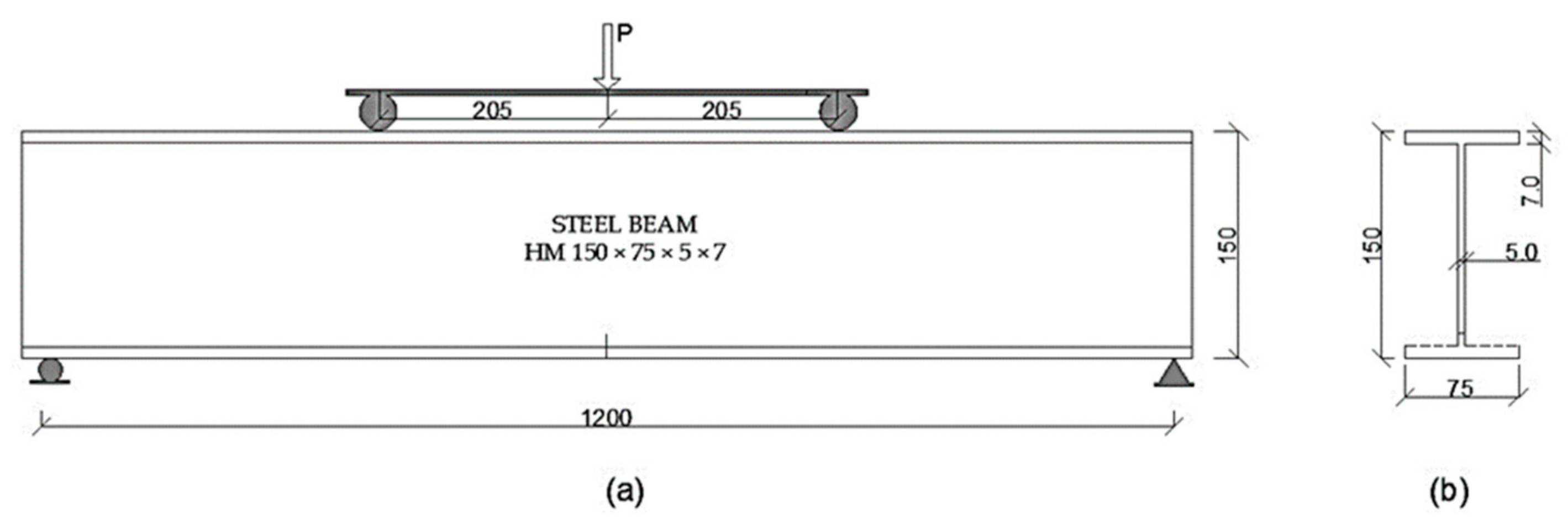
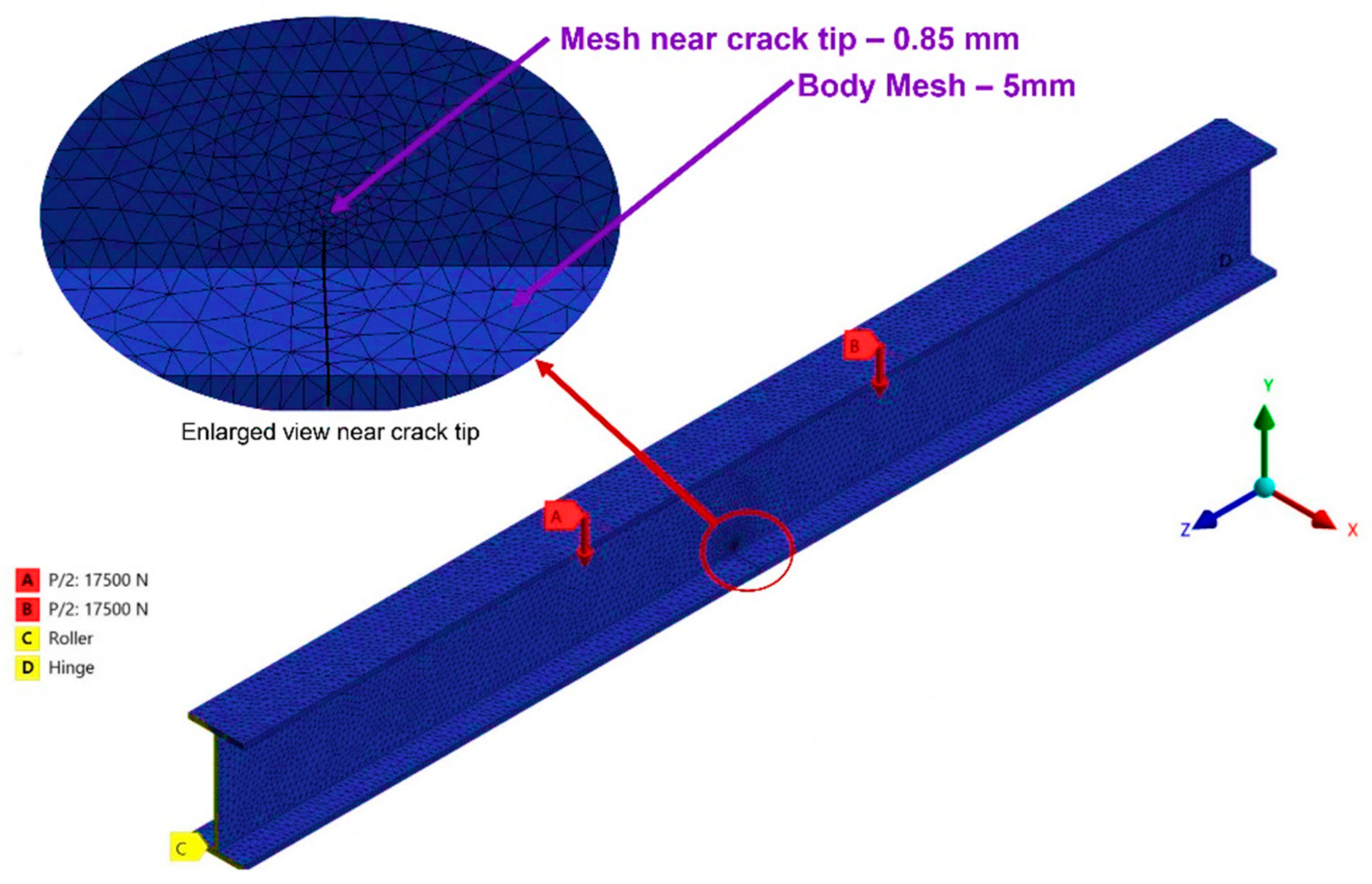


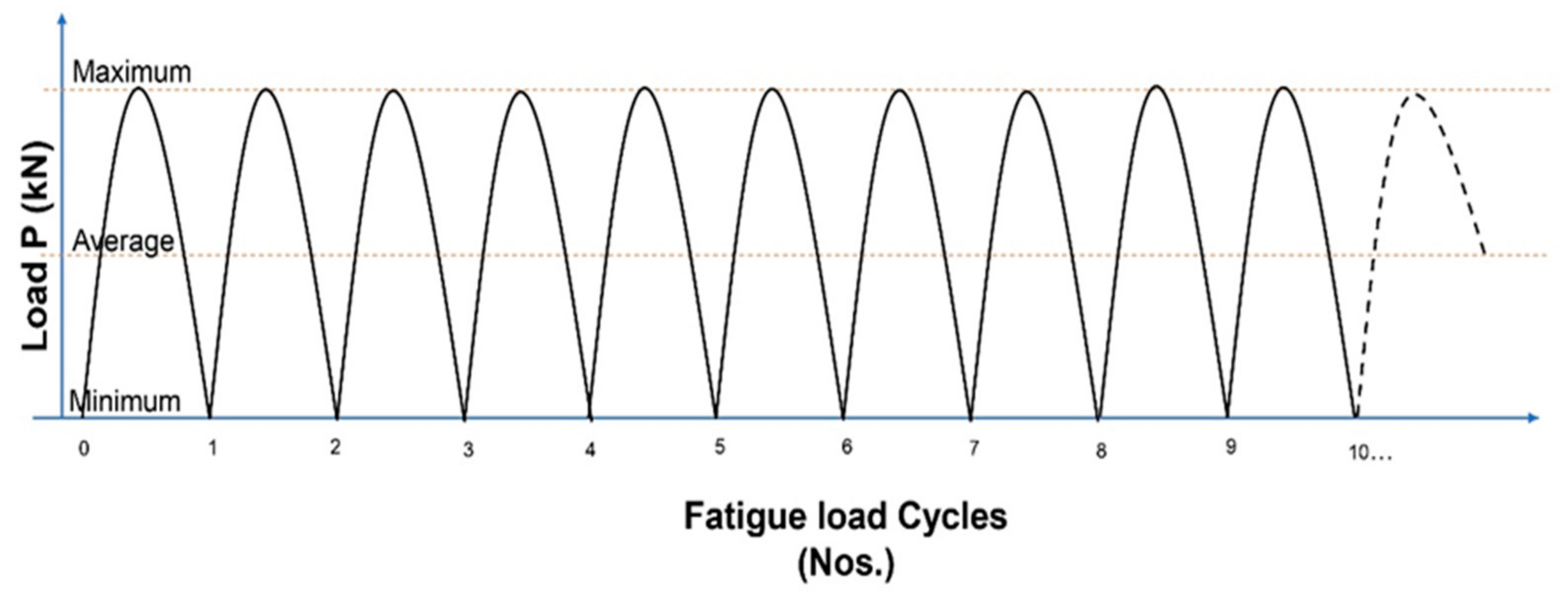
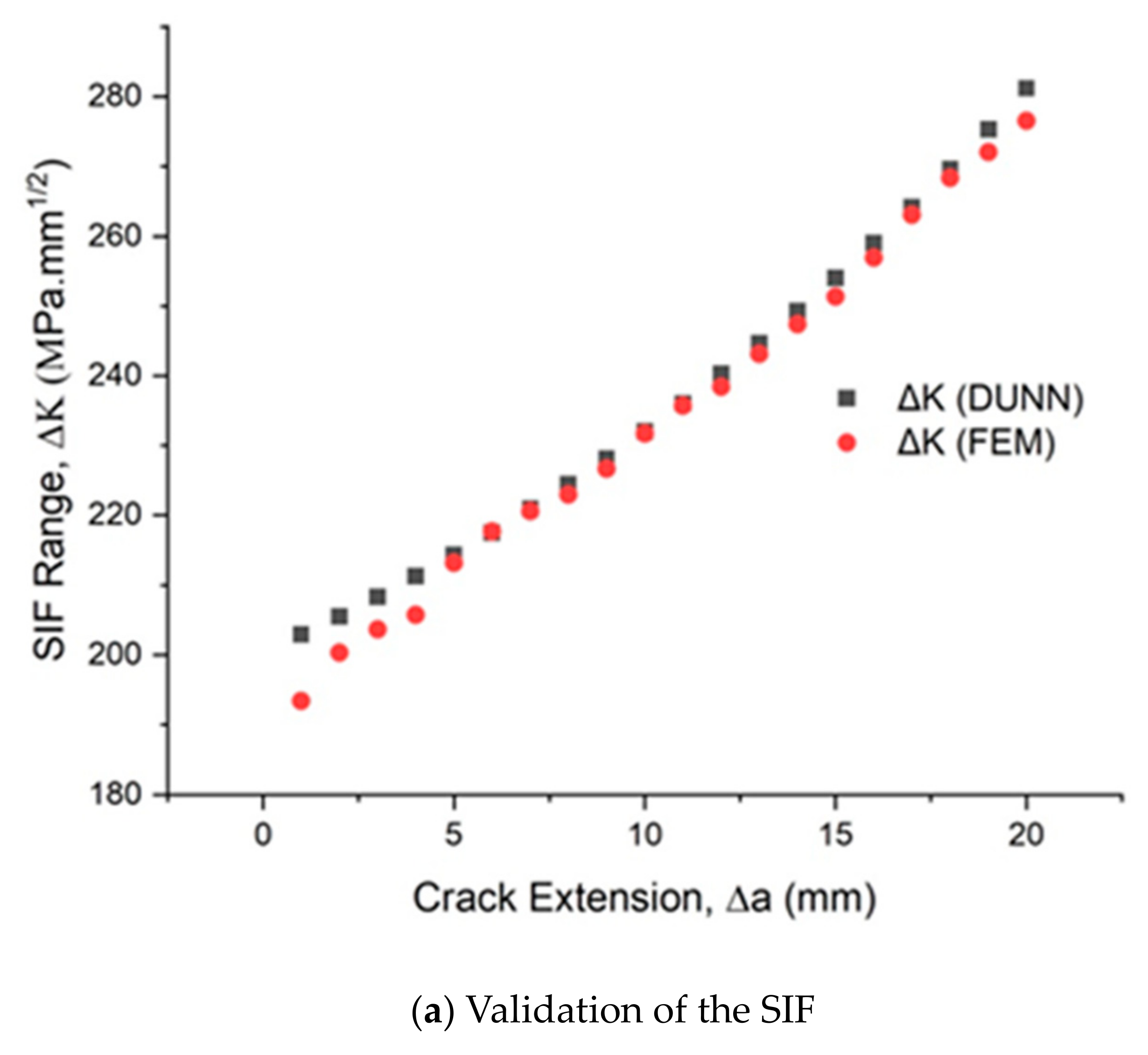
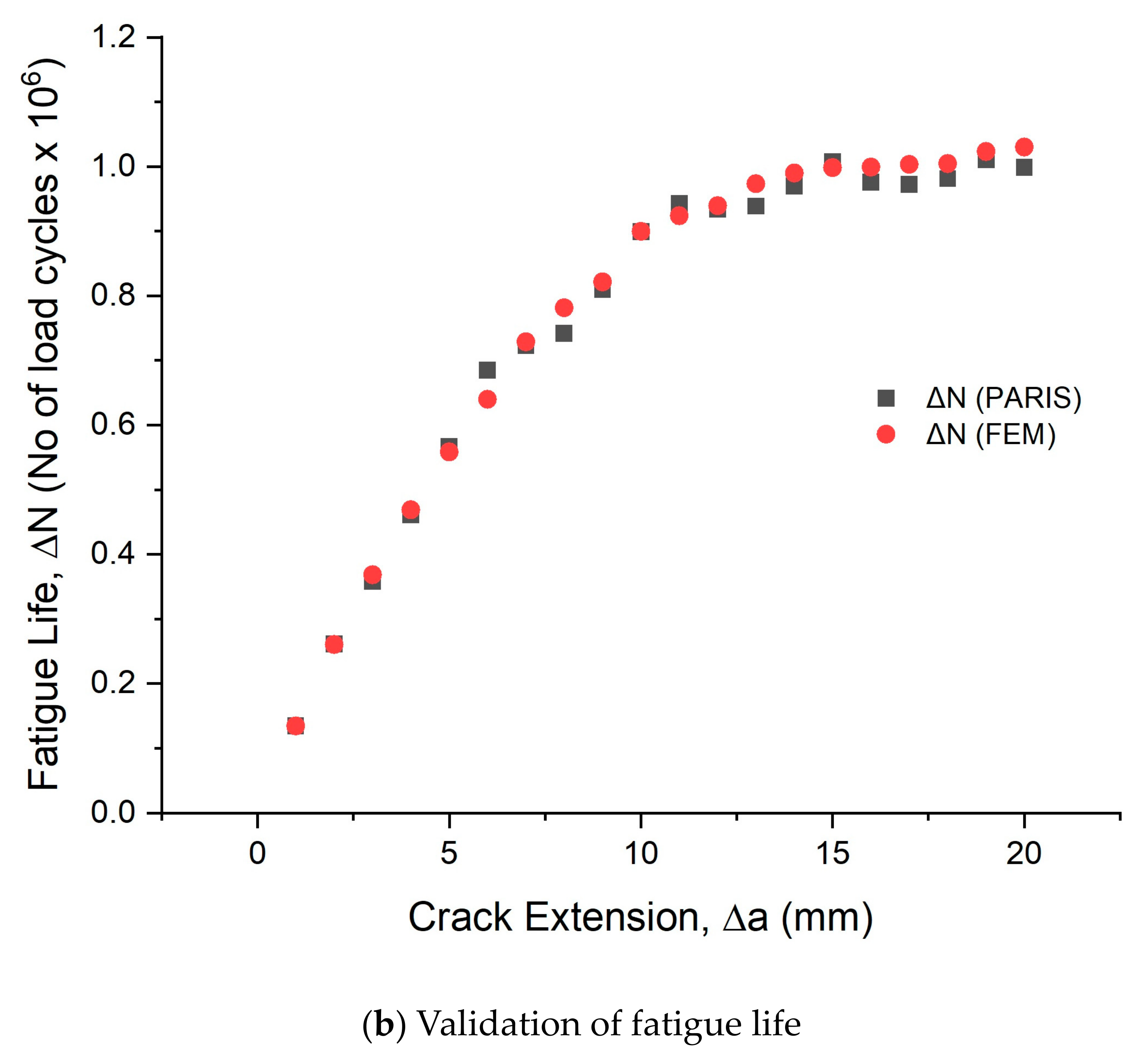
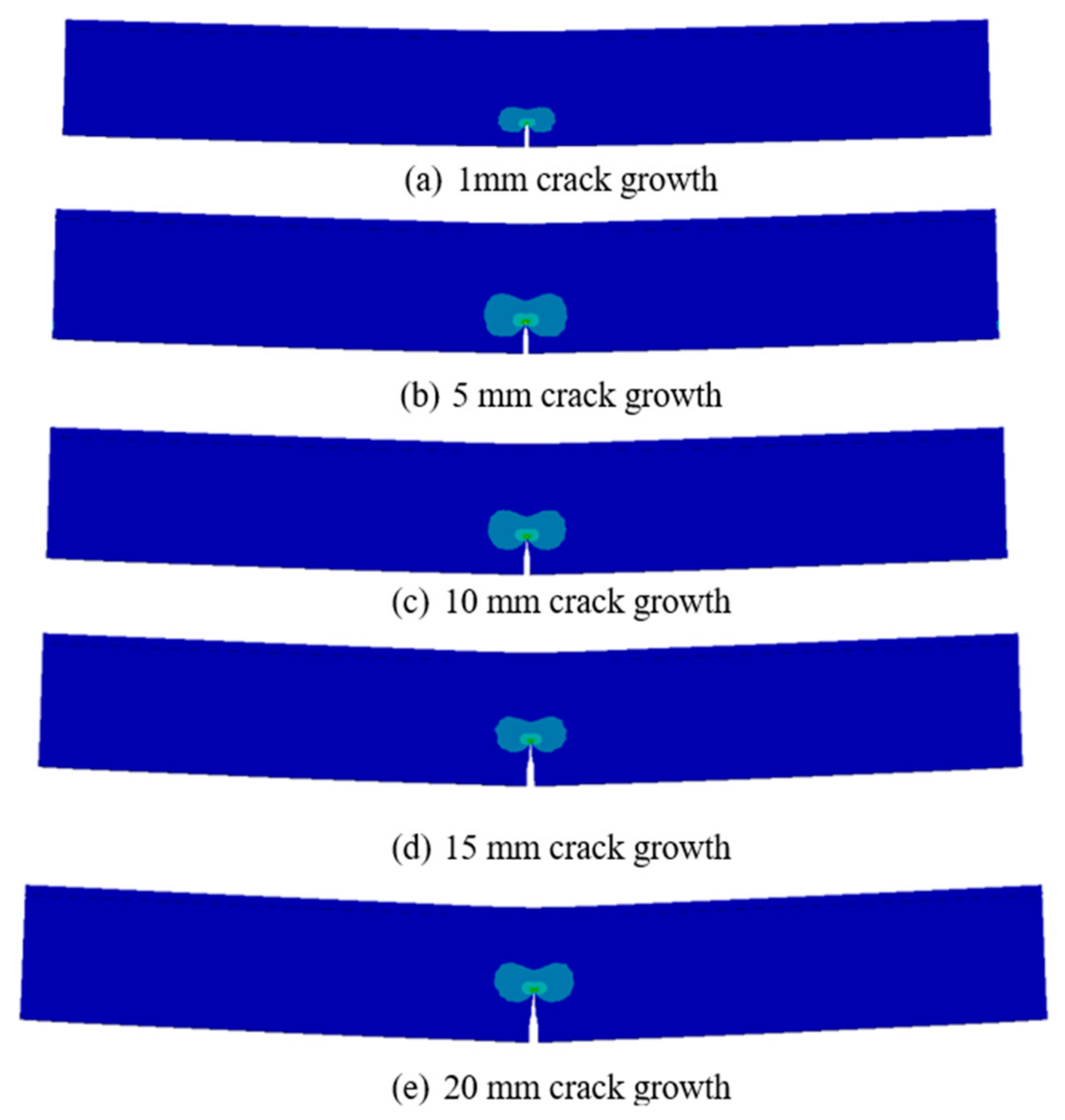
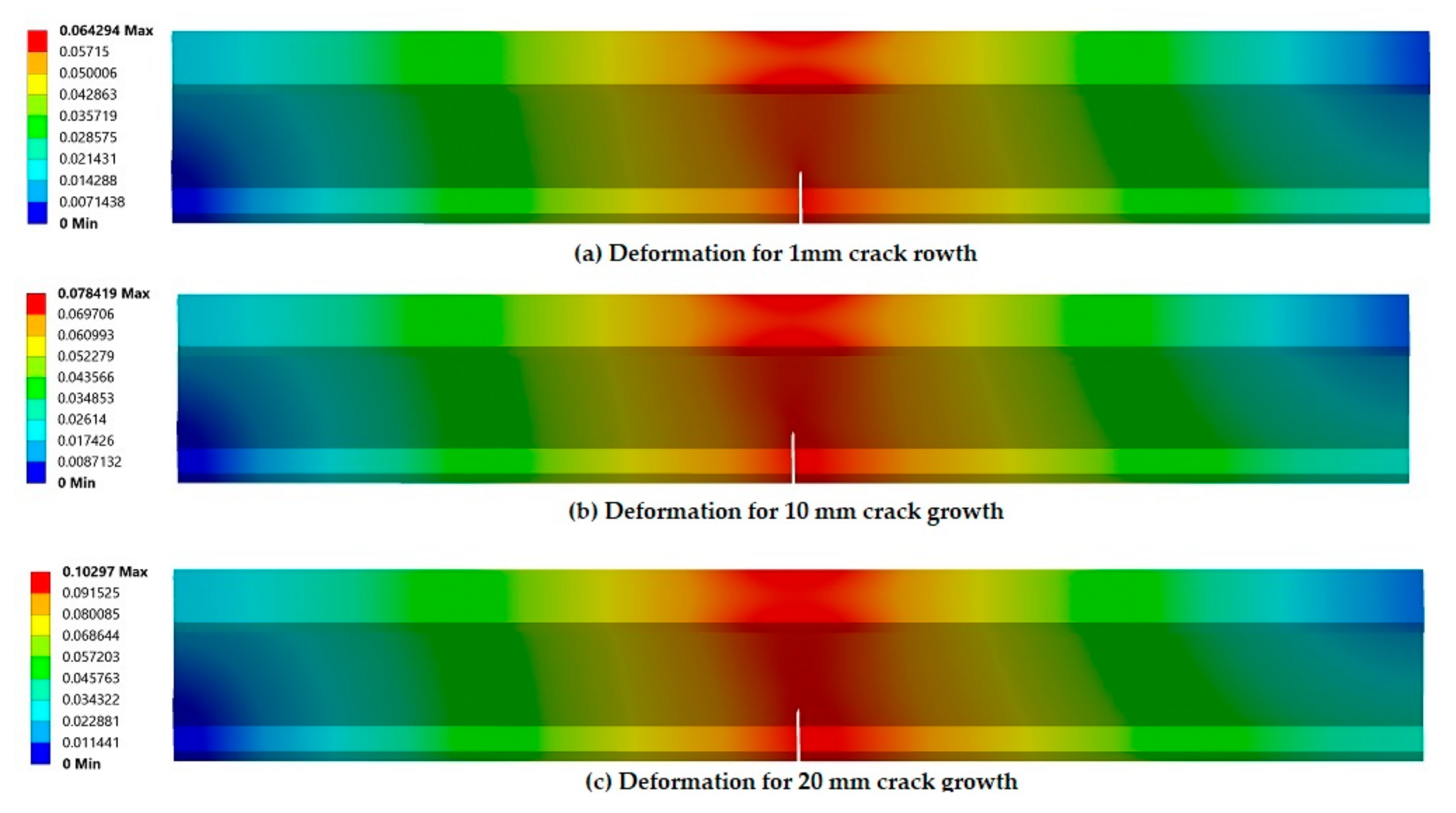
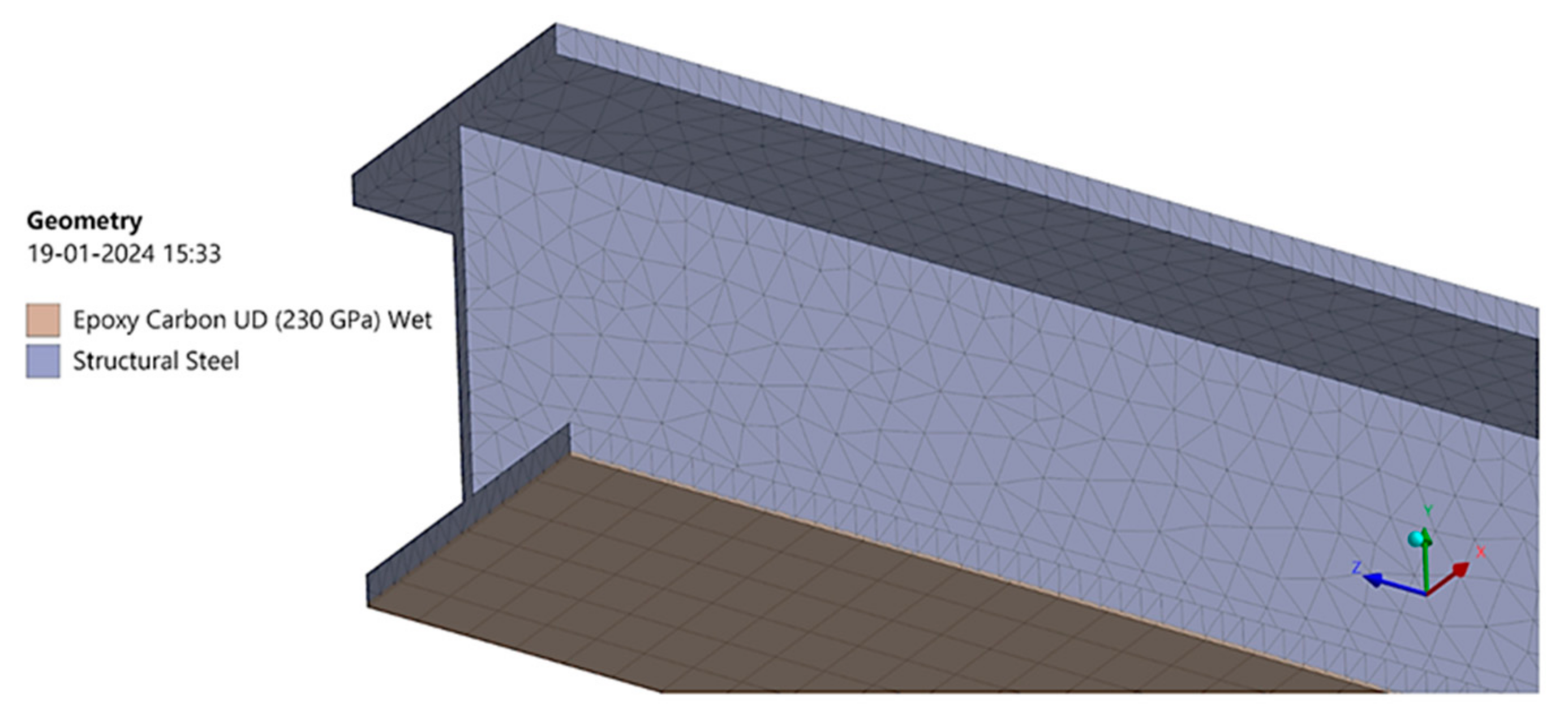
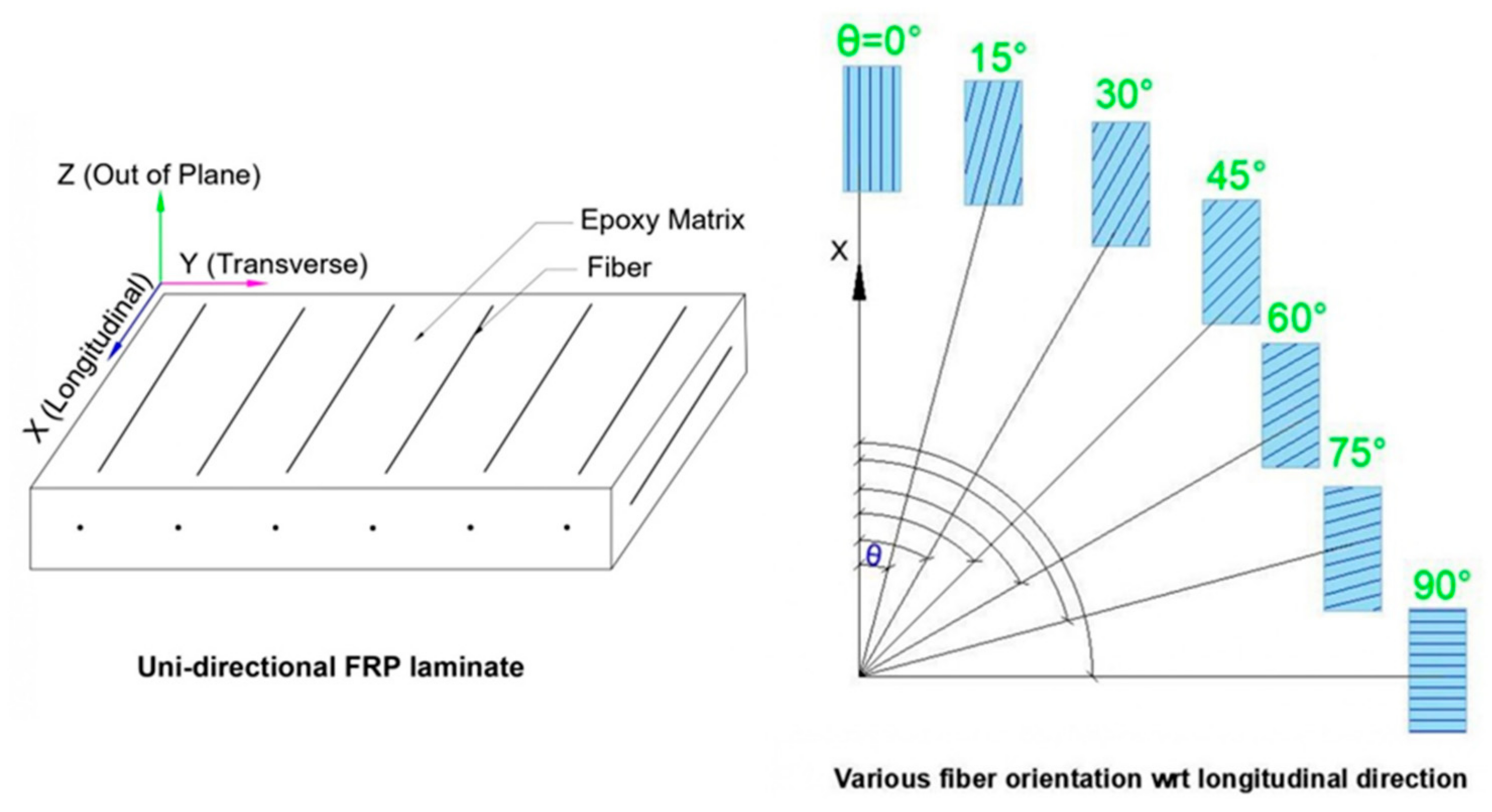


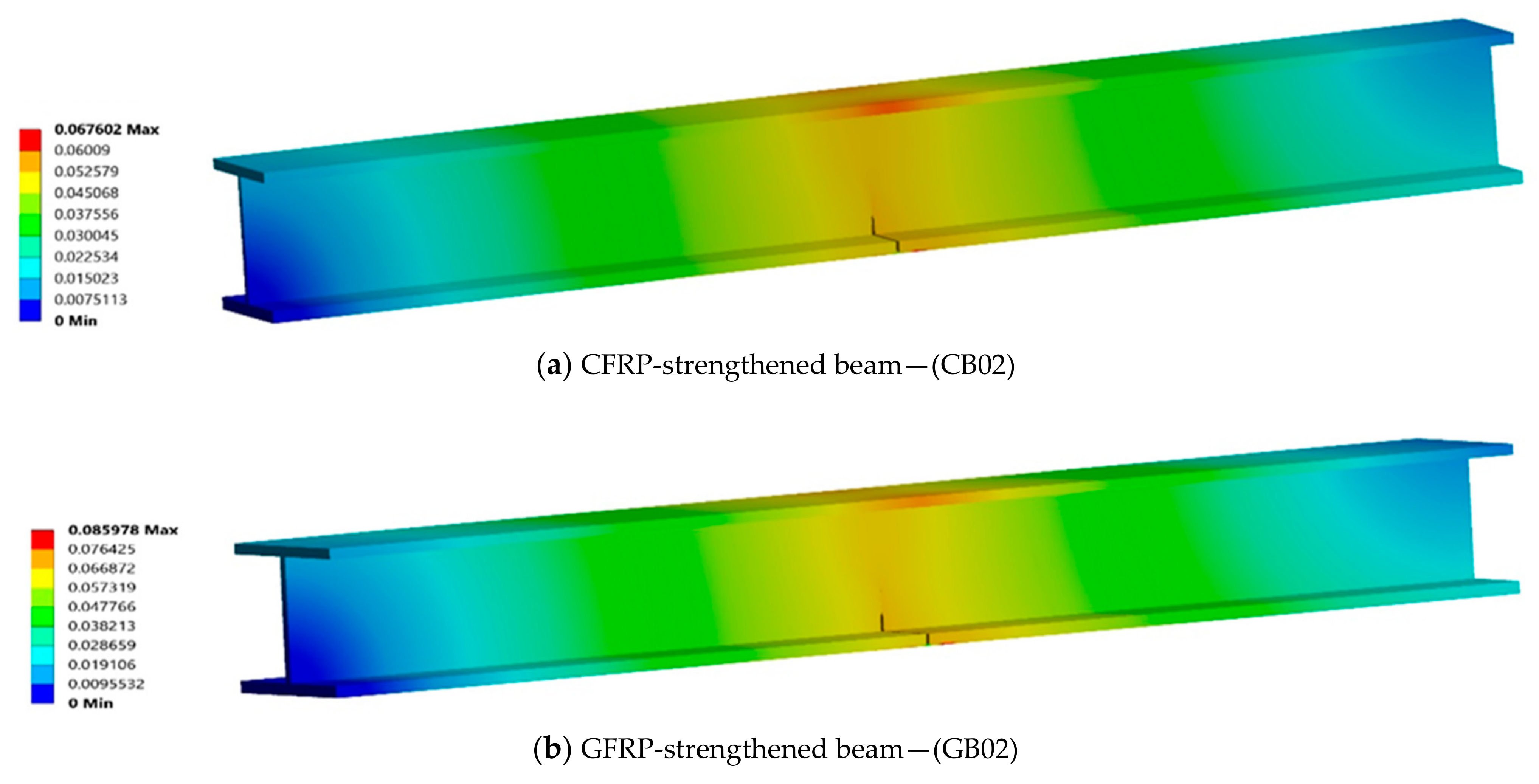
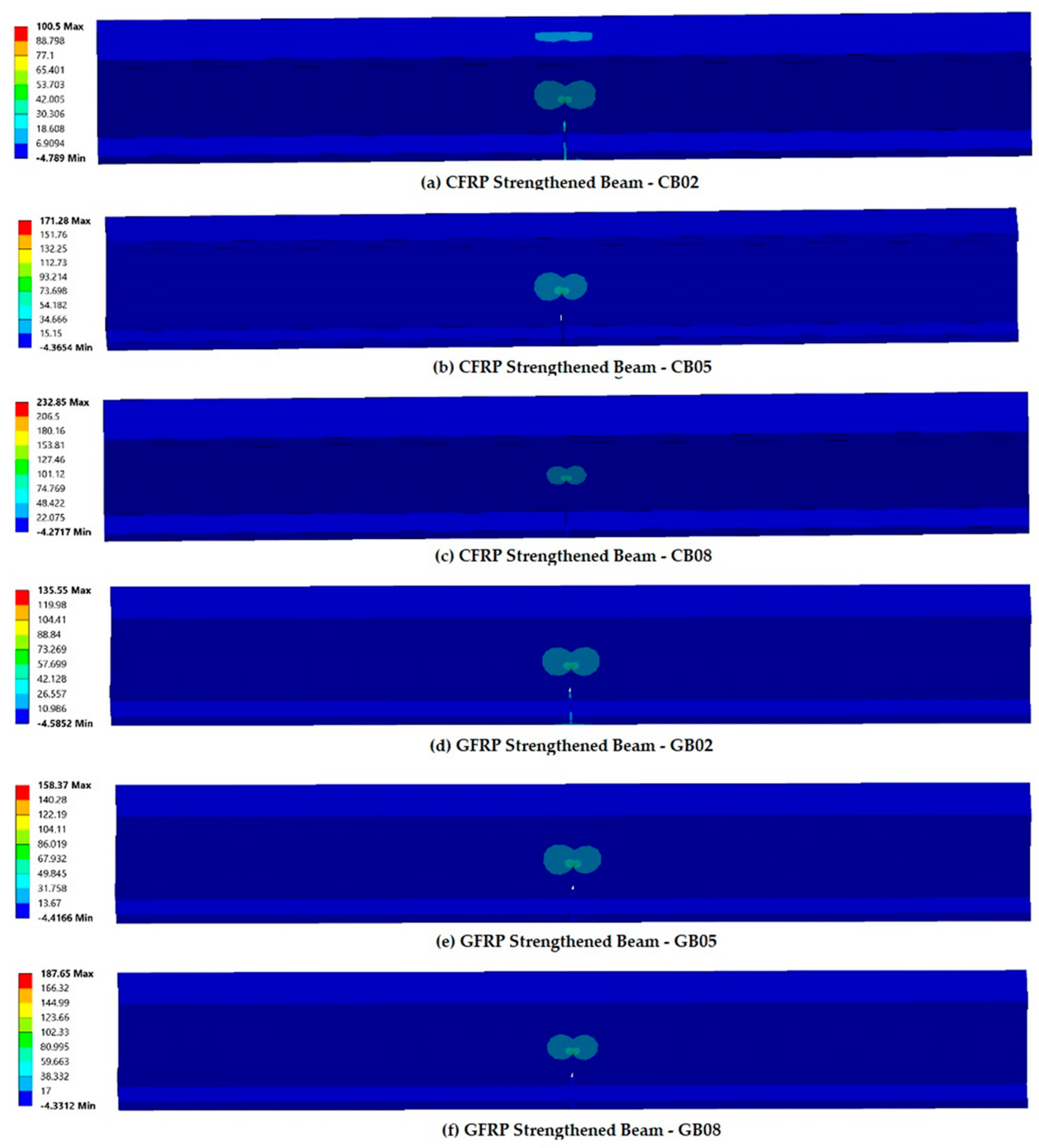
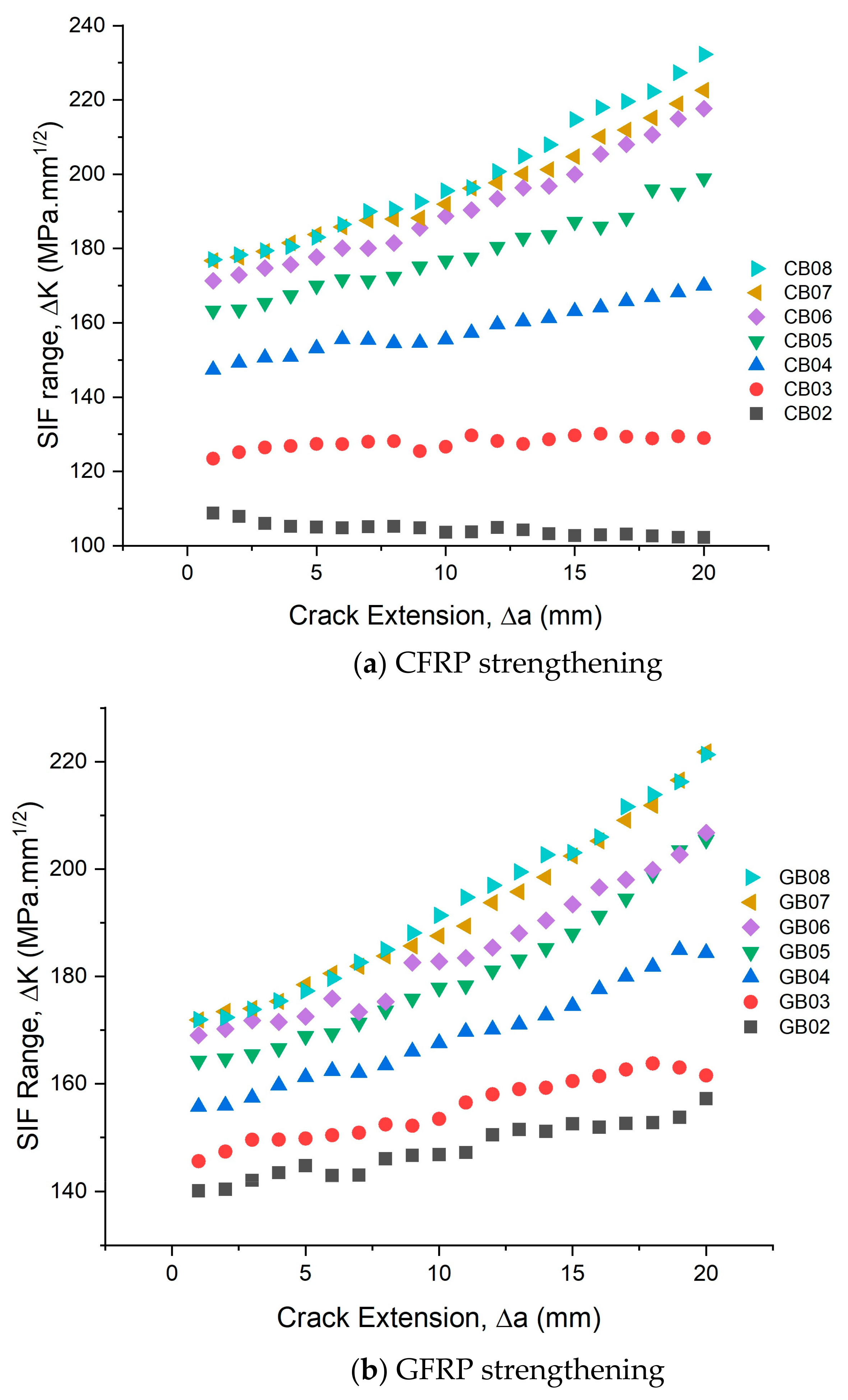

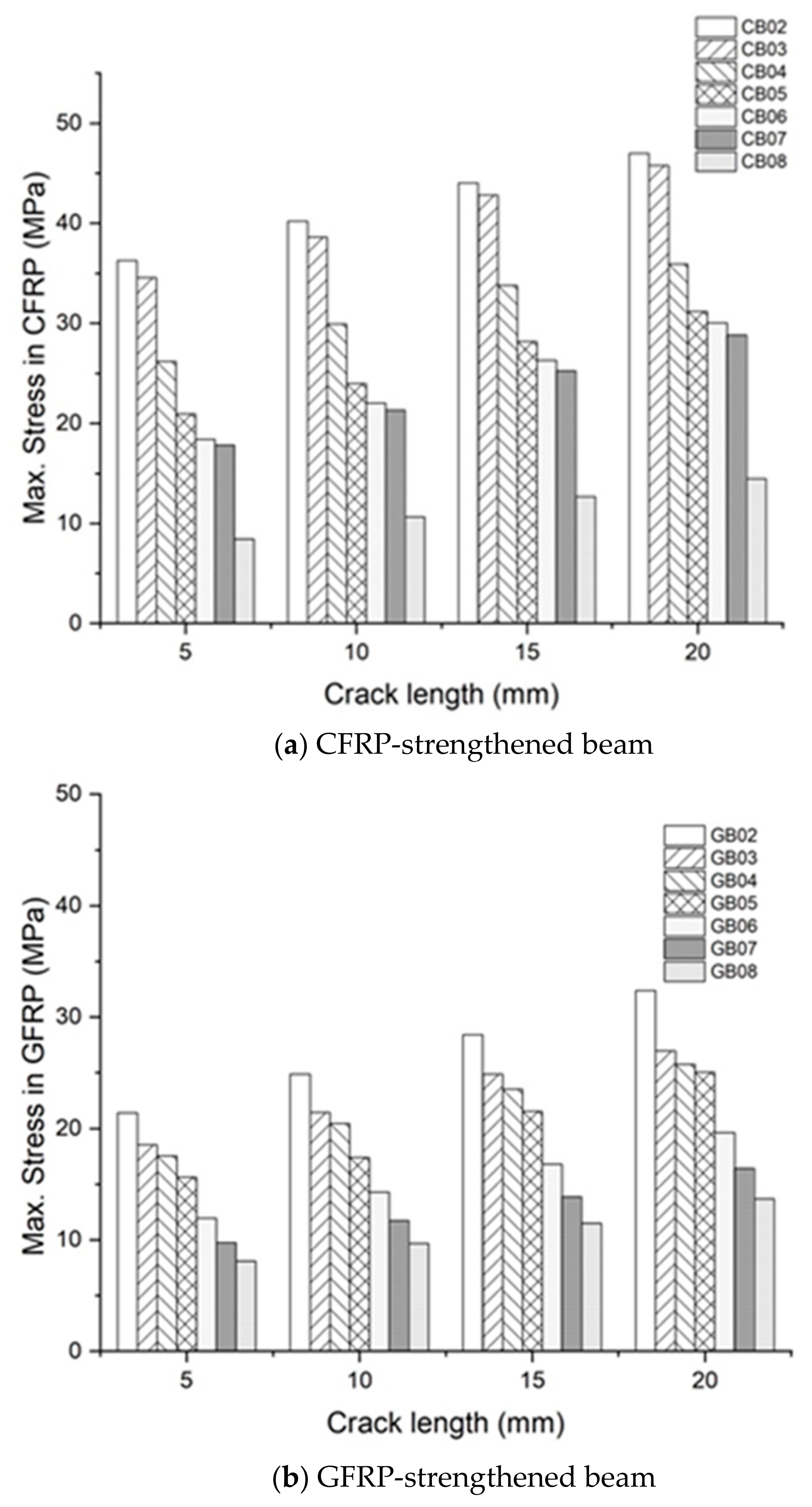

| Crack Extension Δa (mm) | Experimental Results (Yu and Wu [45]) | Theoretical Results (Dunn) | Numerical Study | |||||
|---|---|---|---|---|---|---|---|---|
| SMART UMM | Error % | Default Mesh (5 mm) | Error % | Default Mesh (1 mm) | Error % | |||
| 5 | 2444.85 | 2874.37 | 3003.61 | 4.50 | 1058.61 | 63.17 | 1163.84 | 59.50 |
| 15 | 2977.94 | 3103.59 | 3382.54 | 8.99 | 1204.59 | 61.18 | 1308.32 | 57.84 |
| 25 | 3014.70 | 3432.19 | 3760.72 | 9.57 | 1451.41 | 57.71 | 1565.14 | 54.39 |
| 35 | 3602.94 | 3863.29 | 4138.85 | 7.13 | 1878.82 | 51.36 | 2007.96 | 48.02 |
| 45 | 4650.73 | 4423.88 | 4517.24 | 2.11 | 2357.50 | 46.70 | 2502.76 | 43.42 |
| 55 | 5606.62 | 5165.42 | 4893.86 | 5.26 | 3219.01 | 37.68 | 3385.73 | 34.45 |
| Property | Value (Units) | Dimensions of Beam (mm) |
|---|---|---|
| Yield strength, σy | 250 MPa | h = 100 bf = 75 mm tf =7.2 mm tw = 4 mm |
| Tensile strength, σu | 460 MPa | |
| Young’s modulus, E | 200 GPa | |
| Poisson’s ratio, ν | 0.30 | |
| Paris’ law coefficient, C | 3.80 × 10−12 | |
| Paris’ law exponent, m | 2.75 |
| Reinforcing Material | Beam ID | Fiber Braid Angle | Properties (MPa) |
|---|---|---|---|
| CFRP | CB02 | 0° | σt—2450 Ex, Ey, Ez—160,000, 8600, 8600 μxy, μyz, μzx—0.27, 0.42, 0.27 Gxy, Gyz, Gzx—4700, 3100, 4700 |
| CB03 | 15° | ||
| CB04 | 30° | ||
| CB05 | 45° | ||
| CB06 | 60° | ||
| CB07 | 75° | ||
| CB08 | 90° | ||
| GFRP | GB02 | 0° | σt—850 Ex, Ey, Ez—45,000, 6250, 6250 μxy, μyz, μzx—0.2, 0.21, 0.2 Gxy, Gyz, Gzx—3630, 2050, 3630 |
| GB03 | 15° | ||
| GB04 | 30° | ||
| GB05 | 45° | ||
| GB06 | 60° | ||
| GB07 | 75° | ||
| GB08 | 90° |
| Beam | Fatigue Life at af = 40 mm | Fatigue Life Enhancement Factor |
|---|---|---|
| B01 | 10,30,087 | - |
| CB02 | 1,57,00,996 | 15.24 |
| CB03 | 82,66,389 | 8.02 |
| CB04 | 38,95,383 | 3.78 |
| CB05 | 25,17,837 | 2.44 |
| CB06 | 20,18,281 | 1.96 |
| CB07 | 19,53,097 | 1.90 |
| CB08 | 16,84,899 | 1.64 |
| GB02 | 48,22,883 | 4.68 |
| GB03 | 44,53,515 | 4.32 |
| GB04 | 31,19,648 | 3.03 |
| GB05 | 23,38,834 | 2.27 |
| GB06 | 22,93,847 | 2.23 |
| GB07 | 19,08,362 | 1.85 |
| GB08 | 19,23,416 | 1.87 |
Disclaimer/Publisher’s Note: The statements, opinions and data contained in all publications are solely those of the individual author(s) and contributor(s) and not of MDPI and/or the editor(s). MDPI and/or the editor(s) disclaim responsibility for any injury to people or property resulting from any ideas, methods, instructions or products referred to in the content. |
© 2024 by the authors. Licensee MDPI, Basel, Switzerland. This article is an open access article distributed under the terms and conditions of the Creative Commons Attribution (CC BY) license (https://creativecommons.org/licenses/by/4.0/).
Share and Cite
Thiruvannamalai, M.; Venkatesan, P.V.@.; Chellapandian, M. Fatigue Life Predictions Using a Novel Adaptive Meshing Technique in Non-Linear Finite Element Analysis. Buildings 2024, 14, 3063. https://doi.org/10.3390/buildings14103063
Thiruvannamalai M, Venkatesan PV@, Chellapandian M. Fatigue Life Predictions Using a Novel Adaptive Meshing Technique in Non-Linear Finite Element Analysis. Buildings. 2024; 14(10):3063. https://doi.org/10.3390/buildings14103063
Chicago/Turabian StyleThiruvannamalai, M., P. Vincent @ Venkatesan, and Maheswaran Chellapandian. 2024. "Fatigue Life Predictions Using a Novel Adaptive Meshing Technique in Non-Linear Finite Element Analysis" Buildings 14, no. 10: 3063. https://doi.org/10.3390/buildings14103063
APA StyleThiruvannamalai, M., Venkatesan, P. V. @., & Chellapandian, M. (2024). Fatigue Life Predictions Using a Novel Adaptive Meshing Technique in Non-Linear Finite Element Analysis. Buildings, 14(10), 3063. https://doi.org/10.3390/buildings14103063







